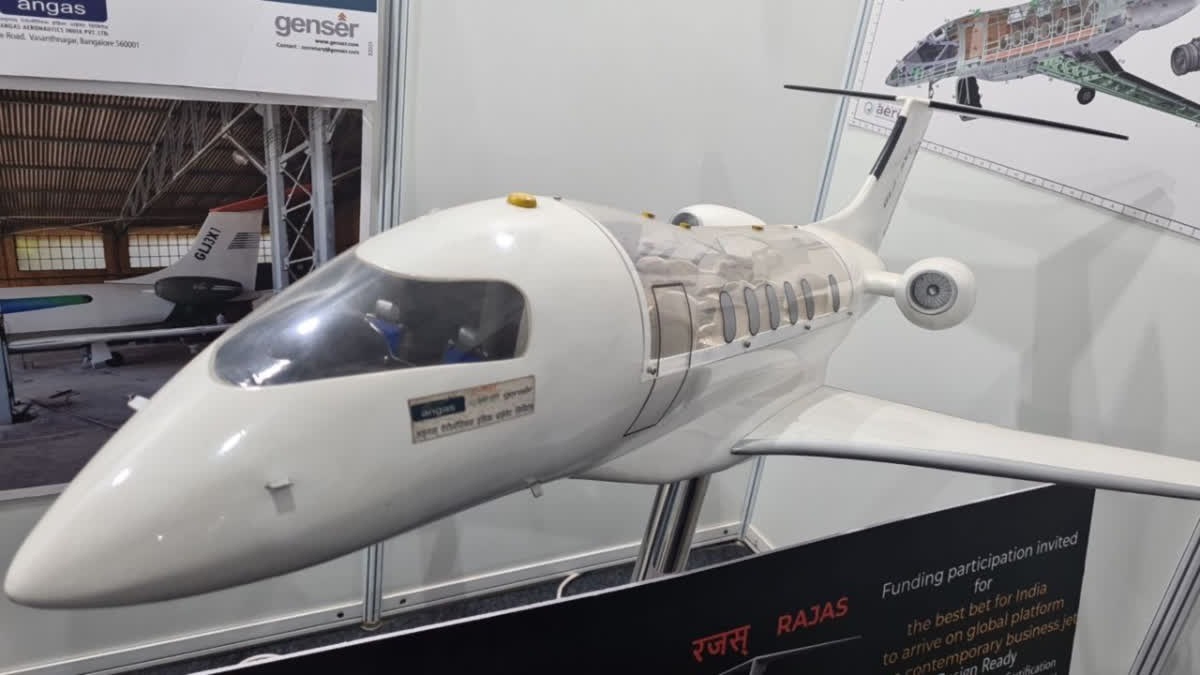Bengaluru: An indigenous technology-enabled business jet which is showcased at the Invest Karnataka - Global Investors Meet 2025, marked a significant milestone in India's aviation sector. The aircraft, capable of flying at a speed of 0.75 Mach (approximately 800-900 km per hour), has a range of 4,000 km, making the 7+2 seater suitable for crossing countries and oceans.
Speaking to ETV Bharat, Aravind KS, design team lead at Genser Aerospace & IT Pvt. Ltd., highlighted that the company is responsible for manufacturing the complete structure of the aircraft. While the research and development process is entirely indigenous, the company sources its engine and other essential parts from foreign manufacturers, alongside procuring critical components from Indian suppliers.
He noted that currently, no indigenous business jet exists in India, with available options being foreign-made. Developing an indigenous aircraft would significantly reduce operational costs and simplify maintenance, making it a viable alternative for the domestic aviation market.
Genser Aerospace is in the process of developing a prototype to obtain certification from the Directorate General of Civil Aviation (DGCA) and other relevant authorities. The broader goal is to strengthen the aviation supply chain in India by encouraging local suppliers to design and produce aviation components. The company is closely collaborating with Hindustan Aeronautics Limited (HAL), which is also advocating for the development of indigenous aerospace systems.
With the domestic aviation sector expanding rapidly due to the establishment of airports in district regions, Genser Aerospace aims to develop business jets that cater to this growing demand. The organization is currently seeking financial backing of approximately ₹3,000 crore to launch the first prototype.
The GenJet GLJ3X1-B Rajas-Rakshan has been designed for multiple applications, including military, VIP transport, reconnaissance, and medical emergencies. It can perform special mission military roles such as lightweight cargo transport, with a payload capacity of approximately 800 kg for long-range flights, which can be increased for shorter distances. For VIP movement, the aircraft offers configurations for four to seven passengers with luxury facilities onboard, and a five-foot standing space in the front section behind the flight deck for enhanced comfort during long flights.
The aircraft is also suitable for aerial and electronic reconnaissance, capable of carrying advanced equipment for photo, infrared, and synthetic aperture radar imaging. With its high speed and altitude, it can perform electronic surveillance and warfare roles and function alongside other aircraft in escort or aggressor missions. In maritime and overland surveillance, its endurance of over five hours allows extensive monitoring over land and sea, and with suitable modifications, it could potentially be used to dispense ordnance against targets if necessary.
Another key application of the aircraft is serving as a lead-in trainer for large jet transport aircraft, such as the IL-76, C-17, Boeing 737/777, and Airbus 320. Currently, pilots transitioning from turboprops to these large jets do so via simulators, and the Rajas aircraft could provide an intermediate training platform. Additionally, its capabilities as a long-distance air ambulance allow for the transportation of up to six stretcher patients with space for three medical personnel, making it a valuable asset for emergency medical evacuation.
Furthermore, the aircraft is being designed with optionally piloted aircraft (OPA) capabilities, meaning it can be operated in both manned and unmanned modes. This flexibility makes it an ideal platform for missions that require fast and lightweight aircraft with remote-control functionalities.
The unveiling of this indigenous business jet represents a major step forward in India's aviation industry, signaling increased self-reliance and opportunities for investment in the aerospace sector.



